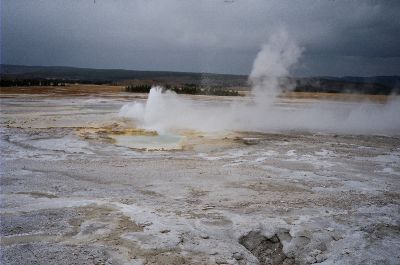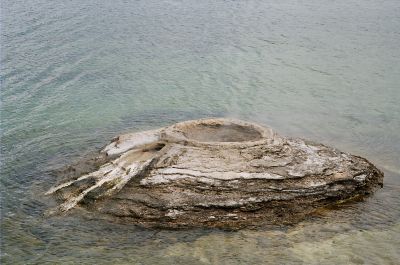by Larry
October, 2006Deadly Cyclesand a time for every matter under heaven: a time to be born, and a time to die..." (Ecclesiastes 3:1-3) Conventional wisdom about Earth's prehistory, which wisdom I shared until recently, holds that for the first one to three billion or so years of life on the planet there was little or no oxygen and that living things then were anaerobic, not merely surviving without the kind of atmosphere we take for granted but so alien that oxygen was poisonous to them, yet that eventually the waste products of living things created so much oxygen that it forced anaerobic microbes into a permanent underworld existence, surviving only in small quantities deep beneath the surface or, ironically perhaps, in the guts of animals, where they assist with the digestive process but are "safe" from the air we take for granted as essential to life. In part, this view appears to be correct. The world we know is, indeed, possible only because oxygen, harmful to anaerobic bacteria when in any significant concentration, permitted a much faster kind of metabolism in modern plants and animals. But what had not been realized previously, and apparently is in fact the case, is that the cycle of transition from anaerobic to aerobic life and back again has been repeated on the surface of our globe several times. It now appears that neither chemical form of life was ever fully victorious. They coexist. Like terrorists locked in continual combat with conventional military powers, at times one side has supremacy, at times the other.
Heretofore, for quite awhile geologists believed that huge comet or asteroid strikes caused most of the mass extinctions of the past 500,000,000 years or so. It does seem definite that the disaster that eventually would kill off perhaps all the dinosaurs (except those that mutated and evolved into modern birds) was the result of such a catastrophic collision. But there were several other major times of extinction, and they may well have been the result of an overwhelmingly deadly cycle characterized by the shift from oxygen breathing plants and animals back to anaerobic bacterial forms as the preeminent species, with a concomitant alteration in the environment to one as foreign to our own as ours is to the bacteria that consider oxygen a toxin. So says the author of a recent "Scientific American" article, "Impact from the Deep." (by Peter D. Ward, Vol. 295, No. 4, pages 64-71; October 2006). The reader is referred to that magazine for the scientific details. The gist of Ward's report, as I understand it, is that under certain conditions there is a "perfect storm," leading to the transition from our own kind of living things to the hegemony of anaerobic bacteria once more. After this occurs, the new paradigm may last for hundreds of thousands or even many millions of years. The elements of this mass extinction scenario are as follows, according to the biologists, chemists, and geologists who developed the hypothesis:
In prior mass die-off catastrophes thought to have been caused by this type sequence, such as the Permian-Triassic Extinction, 95% or more of the prior species ceased to exist. As with virtually all aspects of climate study and researches into Earth's prehistory, there continues to be controversy over this and other hypotheses, though the model is gaining more acceptance.
If it should prove to be valid, is there any concern that we may be close to a new hydrogen sulfide generated mass extinction? Yes. Many aspects of the sea environment are already considered vulnerable. Ozone holes above Antarctica almost annually extend up into the southern hemisphere as far as over the seas around New Zealand, Australia, and parts of South America, resulting in the killing of oxygen producing green phytoplankton in the southern oceans from intense UV radiation. The ocean temperatures are rising, resulting in less oxygen being dissolved in its waters as well as the deaths of many marine species, such as corals, sensitive to minor alterations in salt water temperatures. Pollution is killing additional marine organisms. Ocean Ph levels are also changing, resulting in mollusks and crustaceans, many of which are the basic food of fish and cetaceans, not being able to properly create and maintain their shell structures. There are today a few minor instances of hydrogen sulfide upwelling. For example, per "whyfiles.org, in its 1/31/02 article, "Ocean Belch," there are fairly routine eruptions of hydrogen sulfide along the coast of Namibia . It is probable nobody really knows just what level of atmospheric, marine, and temperature insults would be required to break down the "chemocline" and eventually release large quantities of hydrogen sulfide from the depths. It may, on the face of it, sound like a far-fetched idea. Yet evidence is accumulating that this "chemocline" breakdown and subsequent massive hydrogen sulfide eruption has occurred more than once in the past, leading to some of the worst disasters for previous species, and that the globe's natural balances are never terribly far from such a tipping point. Just as one example, prior to the Industrial Revolution the prevailing level of carbon dioxide in the atmosphere was 280 parts per million by volume (ppmv). Today it is about 400 ppmv and increasing fairly rapidly. Research into prehistoric greenhouse gas levels indicates carbon dioxide was at about 1000 ppmv at the time of the prior mass extinctions felt to be from the above type sequence. But it is not known if that was the required level before the major transformations could occur or simply the end stage level, once they were well underway. In view of how long greenhouse gases tend to remain in the air, and with nothing realistic on the horizon to halt the progression of our environmental excesses, both the continued rise of carbon dioxide's percentage of our atmosphere and its inexorable effects seem virtually certain. The arctic and other permafrost areas are thawing, releasing larger and larger amounts of extra greenhouse gases into the atmosphere. As more forests are cut down, rotting or burned trees release further greenhouse gases. Similarly methane, another major greenhouse gas, is produced by increasing agricultural activity around the world. Carbon dioxide is produced by our growing transportation systems, utilities, industrial production, etc. As mentioned in the last essay, seemingly unquenchable underground coal fires are adding to the problem. In short, from many sources, greenhouse gases will keep increasing and probably at accelerating rates. There is even some speculation that, as the previously miles thick ice sheets melt, their thinning thus reducing the weight on Earth's crust that helps hold in check high pressure volcanic forces, there will also be more eruptions of lava and greenhouse gases from the molten, superheated regions just below. Some scientists estimate, if we do not take radical corrective action, humans have a very short time left before "runaway global warming," perhaps, as in the last issue, only 10 years or less. Others think we have perhaps 200 years before we could reasonably anticipate the beginnings of a new reversal from oxygen breathing to anaerobic life forms and such a huge upwelling of hydrogen sulfide as Ward's "Scientific American" article describes, after which it almost certainly would be far too late to do anything to remedy the situation. It seems unlikely, if the oceans are dying and becoming net hydrogen sulfide, instead of oxygen, producers, that even our kind's great capacity for adaptation will assure the survival of Homo sapiens. Let's hope we do not go there! |
 Just as the planet's electromagnetism shifts radically at times, periodically reversing, so the dominance of aerobic vs. anaerobic living things may come and go as regularly, if far less frequently, as the tides.
Just as the planet's electromagnetism shifts radically at times, periodically reversing, so the dominance of aerobic vs. anaerobic living things may come and go as regularly, if far less frequently, as the tides.
